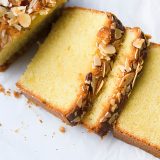I went to Paris to take a baking lesson from an English baker. That may sound like the beginning of a bad joke, but Rose Carrarini has been a leading light on the Paris restaurant scene for 15 years, starting with the original Rose Bakery located near Place Pigalle on Rue des Martyrs. It’s a street that has been transformed from a charming but slightly raffish venue (Pigalle was Paris’ tawdry Times Square) to a stylish destination full of sidewalk cafés, take-out sushi, boutique hotels, high-end cheese shops and patisseries.
Smack in the middle of Rue des Martyrs is Rose Bakery, newly expanded and refurbished, yet committed to its original premise: a tea shop offering simple organic fare, including soups, quiche and vegetable platters married to spectacular baked goods such as pistachio cake, carrot cake and caramel tarts.
During our visit, I asked Carrarini about her baking secrets, one of which is to substitute ground nuts, nut flours and/or rice flour for wheat flour. And this is exactly what she does with one of her signature items, a lemon pound cake—she uses ground almonds for a portion of the wheat flour. Almonds contain more fat than regular flour, adding a richness that makes it possible to cut back on the butter without sacrificing the luscious crumb.
Back at Milk Street, we put Carrarini’s pound cake method to the test. This can be a troublesome recipe since it often comes out too heavy, too greasy or too dry. Though Carrarini has no problem turning out the perfect lemon pound cake, we wanted a bit of insurance to make sure this recipe would perform well in anyone’s kitchen.
Most pound cakes follow the same trajectory. Cream the butter and sugar, beat in the whole eggs, then add the flour. Creaming introduces air bubbles that later expand as the leavener reacts with the oven’s heat, helping the batter rise. (Many traditional pound cake recipes don’t include a leavener, putting a heavy responsibility on the skill of the home baker.)
Given the amount of fat in pound cakes from all the butter and eggs, they are particularly sensitive to the temperature of the ingredients to form a good emulsion. So we borrowed a common mixing approach, one favored by Rose Levy Beranbaum in “The Cake Bible,” called reverse creaming. The dry ingredients are combined first, then room-temperature butter is added to coat the flour (this helps prevent gluten formation and keeps the cake tender). Only then are the liquid ingredients beaten in. Problem solved.
For extra texture, after pouring our modified batter into a prepared loaf pan, we sprinkled the top with sliced almonds. And because we had to account for the density of the batter, we started the oven at 325°F to set the cake’s structure, then lowered it to 300°F to prevent overbrowning.
While the cake baked, we made an easy syrup from water, sugar and lemon juice. We poked holes in the top of the warm cake and brushed syrup over it, letting it soak in. The tender, lemony result provided bright citrus flavor and the finer crumb that pound cake is known for, plus a lightness that contradicts its heavy reputation.




